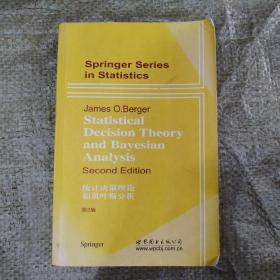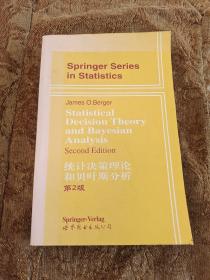
统计决策理论和贝叶斯分析(第2版)
¥ 88 九品
仅1件
作者JamesO.Berger 著
出版社世界图书出版公司
出版时间2004-11
版次1
装帧平装
货号A153
上书时间2023-02-12
- 在售商品 暂无
- 平均发货时间 5小时
- 好评率 暂无
- 最新上架
商品详情
- 品相描述:九品
图书标准信息
- 作者 JamesO.Berger 著
- 出版社 世界图书出版公司
- 出版时间 2004-11
- 版次 1
- ISBN 9787506271813
- 定价 88.00元
- 装帧 平装
- 开本 24开
- 纸张 胶版纸
- 页数 617页
- 【内容简介】
- Therelationships(bothconceptualandmathematical)betweenBayesiananalysisandstatisticaldecisiontheoryaresostrongthatitissomewhatunnaturaltolearnonewithouttheother.Nevertheless,majorportionsofeachhavedevelopedseparately.OntheBayesianside,thereisanextensivelydevelopedBayesiantheoryofstatisticalinference(bothsubjectiveandobjectiveversions).Thistheoryrecognizestheimportanceofviewingstatisticalanalysisconditionally(i.e.,treatingobserveddataasknownratherthanunknown),evenwhennolossfunctionistobeincorporatedintotheanalysis.Thereisalsoawell-developed(frequentist)decisiontheory,whichavoidsformalutilizationofpriordistributionsandseekstoprovideafoundationforfrequentiststatisticaltheory.AlthoughthecentralthreadofthebookwillbeBayesiandecisiontheory,bothBayesianinferenceandnon-Bayesiandecisiontheorywillbeextensivelydiscussed.Indeed,thebookiswrittensoastoallow,say,theteachingofacourseoneithersubjectseparately.
- 【目录】
-
CHAPTER1
BasicConcepts
1.1Introduction
1.2BasicElements
1.3ExpectedLoss,DecisionRules,andRisk
1.3.1BayesianExpectedLoss
1.3.2FrequentistRisk
1.4RandomizedDecisionRules
1.5DecisionPrinciples
1.5.1TheConditionalBayesDecisionPrinciple
1.5.2FrequentistDecisionPrinciples
1.6Foundations
1.6.1MisuseofClassicalInferenceProcedures
1.6.2TheFrequentistPerspective
1.6.3TheConditionalPerspective
1.6.4TheLikelihoodPrinciple
1.6.5ChoosingaParadigmorDecisionPrinciple
1.7SufficientStatistics
1.8Convexity
Exercises
CHAPTER2 UtilityandLoss
2.1Introduction
2.2UtilityTheory
2.3TheUtilityofMoney
2.4TheLossFunction
2.4.1DevelopmentfromUtilityTheory
2.4.2CertainStandardLossFunctions
2.4.3ForInferenceProblems
2.4.4ForPredictiveProblems
2.4.5VectorValuedLossFunctions
2.5Criticisms
Exercises
CHAPTER3 PriorInformationandSubjectiveProbability
3.1SubjectiveProbability
3.2SubjectiveDeterminationofthePriorDensity
3.3NoninformativePriors
3.3.1Introduction
3.3.2NoninformativePriorsforLocationandScaleProblems
3.3.3NoninformativePriorsinGeneralSettings
3.3.4Discussion
3.4MaximumEntropyPriors
3.5UsingtheMarginalDistributiontoDeterminethePrior
3.5.1TheMarginalDistribution
3.5.2InformationAbouttn
3.5.3RestrictedClassesofPriors
3.5.4TheML-IIApproachtoPriorSelection
3.5.5TheMomentApproachtoPriorSelection
3.5.6TheDistanceApproachtoPriorSelection
3.5.7MarginalExchangeability
3.6HierarchicalPriors
3.7Criticisms
3.8TheStatisticiansRole
Exercises
CHAPTER4 BayesianAnalysis
4.1Introduction
4.2ThePosteriorDistribution
4.2.1DefinitionandDetermination
4.2.2ConjugateFamilies
4.2.3ImproperPriors
4.3BayesianInference
4.3.1Estimation
4.3.2CredibleSets
4.3.3HypothesisTesting
4.3.4PredictiveInference
4.4BayesianDecisionTheory
4.4.1PosteriorDecisionAnalysis
4.4.2Estimation
4.4.3FiniteActionProblemsandHypothesisTesting
4.4.4WithInferenceLosses
4.5EmpiricalBayesAnalysis
4.5.1Introduction
4.5.2PEBForNormalMeans--TheExchangeableCase
4.5.3PEBForNormalMeans--TheGeneralCase
4.5.4NonparametricEmpiricalBayesAnalysis
4.6HierarchicalBayesAnalysis
4.6.1Introduction
4.6.2ForNormalMeans--TheExchangeableCase
4.6.3ForNormalMeans--TheGeneralCase
4.6.4ComparisonwithEmpiricalBayesAnalysis
4.7BayesianRobustness
4.7.1Introduction
4.7.2TheRoleoftheMarginalDistribution
4.7.3PosteriorRobustness:BasicConcepts
4.7.4PosteriorRobustness:s-ContaminationClass
4.7.5BayesRiskRobustnessandUseofFrequentistMeasures
4.7.6Gamma-MinimaxApproach
4.7.7UsesoftheRiskFunction
4.7.8SomeRobustandNonrobustSituations
4.7.9RobustPriors
4.7.10RobustPriorsforNormalMeans
4.7.11OtherIssuesinRobustness
4.8AdmissibilityofBayesRulesandLongRunEvaluations
4.8.1AdmissibilityofBayesRules
4.8.2AdmissibilityofGeneralizedBayesRules
4.8.3InadmissibilityandLongRunEvaluations
4.9BayesianCalculation
4.9.1NumericalIntegration
4.9.2MonteCarloIntegration
4.9.3AnalyticApproximations
4.10BayesianCommunication
4.10.1Introduction
4.10.2AnIllustration:TestingaPointNullHypothesis
4.11CombiningEvidenceandGroupDecisions
4.11.1CombiningProbabilisticEvidence
4.11.2CombiningDecision-TheoreticEvidence
4.11.3GroupDecisionMaking
4.12Criticisms
4.12.1Non-BayesianCriticisms
4.12.2FoundationalCriticisms
Exercises
CHAPTER5 MinimaxAnalysis
5.1Introduction
5.2GameTheory
5.2.1BasicElements
5.2.2GeneralTechniquesforSolvingGames
5.2.3FiniteGames
5.2.4GameswithFinite
5.2.5TheSupportingandSeparatingHyperplaneTheorems
5.2.6TheMinimaxTheorem
5.3StatisticalGames
5.3.1Introduction
5.3.2GeneralTechniquesforSolvingStatisticalGames
5.3.3StatisticalGameswithFinite
5.4ClassesofMinimaxEstimators
5.4.1Introduction
5.4.2TheUnbiasedEstimatorofRisk
5.4.3MinimaxEstimatorsofaNormalMeanVector
5.4.4MinimaxEstimatorsofPoissonMeans
5.5EvaluationoftheMinimaxPrinciple
5.5.1AdmissibilityofMinimaxRules
5.5.2RationalityandtheMinimaxPrinciple
5.5.3ComparisonwiththeBayesianApproach
5.5.4TheDesiretoActConservatively
5.5.5MinimaxRegret
5.5.6Conclusions
Exercises
CHAPTER6 Invariance
6.1Introduction
6.2Formulation
6.2.1GroupsofTransformations
6.2.2InvariantDecisionProblems
6.2.3InvariantDecisionRules
6.3LocationParameterProblems
6.4OtherExamplesofInvariance
6.5Maximallnvariants
6.6InvarianceandNoninformativePriors
6.6.1RightandLeftInvariantHaarDensities
6.6.2TheBestInvariantRule
6.6.3ConfidenceandCredibleSets
6.7InvarianceandMinimaxity
6.8AdmissibilityofInvariantRules
6.9Conclusions
Exercises
CHAPTER7 PreposteriorandSequentialAnalysis
7.1Introduction
7.2OptimalFixedSampleSize
7.3SequentialAnalysis--Notation
7.4BayesianSequentialAnalysis
7.4.1Introduction
7.4.2Notation
7.4.3TheBayesDecisionRule
7.4.4ConstantPosteriorBayesRisk
7.4.5TheBayesTruncatedProcedure
7.4.6LookAheadProcedures
7.4.7InnerTruncation
7.4.8ApproximatingtheBayesProcedureandtheBayesRisk
7.4.9TheoreticalResults
7.4.10OtherTechniquesforFindingaBayesProcedure
7.5TheSequentialProbabilityRatioTest
7.5.1TheSPRTasaBayesProcedure
7.5.2ApproximatingthePowerFunctionandtheExpectedSampleSize
7.5.3AccuracyoftheWaldApproximations
7.5.4BayesRiskandAdmissibility
7.5.5OtherUsesoftheSPRT
7.6MinimaxSequentialProcedures
7.7TheEvidentialRelevanceoftheStoppingRule
7.7.1Introduction
7.7.2TheStoppingRulePrinciple
7.7.3PracticalImplications
7.7.4CriticismsoftheStoppingRulePrinciple
7.7.5InformativeStoppingRules
7.8DiscussionofSequentialLossFunctions
Exercises
CHAPTER8 CompleteandEssentiallyCompleteClasses
8.1Preliminaries
8.2CompleteandEssentiallyCompleteClassesfromEarlierChapters
8.2.1DecisionRulesBasedonaSufficientStatistic
8.2.2NonrandomizedDecisionRules
8.2.3FiniteO
8.2.4TheNeyman-PearsonLemma
8.3One-SidedTesting
8.4MonotoneDecisionProblems
8.4.1MonotoneMultipleDecisionProblems
8.4.2MonotoneEstimationProblems
8.5LimitsofBayesRules
8.6OtherCompleteandEssentiallyCompleteClassesofTests
8.6.1Two-SidedTesting
8.6.2HigherDimensionalResults
8.6.3SequentialTesting
8.7CompleteandEssentiallyCompleteClassesinEstimation
8.7.1GeneralizedBayesEstimators
8.7.2IdentifyingGeneralizedBayesEstimators
8.8ContinuousRiskFunctions
8.9ProvingAdmissibilityandInadmissibility
8.9.1SteinsNecessaryandSufficientConditionforAdmissibility
8.9.2ProvingAdmissibility
8.9.3ProvingInadmissibility
8.9.4MinimalorNearlyMinimalCompleteClasses
Exercises
APPENDIX1 CommonStatisticalDensities
IContinuous
IIDiscrete
APPENDIX2 SupplementtoChapter4
IDefinitionandPropertiesofHm
IIDevelopmentof(4.121)and(4.122)
IIIVerificationofFormula(4.123)
APPENDIX3 TechnicalArgumentsfromChapter7
IVerificationofFormula(7.8)
IIVerificationofFormula(7.10)
Bibliography
NotationandAbbreviations
AuthorIndex
SubjectIndex
相关推荐
-

统计决策理论和贝叶斯分析(第2版)
全新保定
¥ 61.70
-

统计决策理论和贝叶斯分析(第2版)
全新保定
¥ 61.70
-

统计决策理论和贝叶斯分析(第2版)
九品武汉
¥ 45.00
-

统计决策理论和贝叶斯分析(第2版)
八五品武汉
¥ 25.00
-

统计决策理论和贝叶斯分析(第2版)
八品南昌
¥ 20.00
-

统计决策理论和贝叶斯分析(第2版)
八五品周口
¥ 38.00
-

统计决策理论和贝叶斯分析(第2版)
八五品广州
¥ 60.00
-

统计决策理论和贝叶斯分析(第2版)
全新海口
¥ 118.00
-

统计决策理论和贝叶斯分析(第2版)
八五品北京
¥ 35.00
-

统计决策理论和贝叶斯分析(第2版)
九品阜阳
¥ 48.00
— 没有更多了 —





![空间圣经:斯塔克与鬼才设计大师们的顶尖设计 [精装]](https://www0.kfzimg.com/sw/kfz-cos/kfzimg/feaeacbc/903805b5a27c2f72_s.jpg)









以下为对购买帮助不大的评价